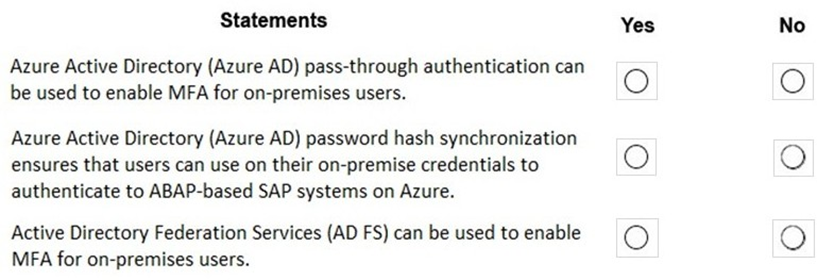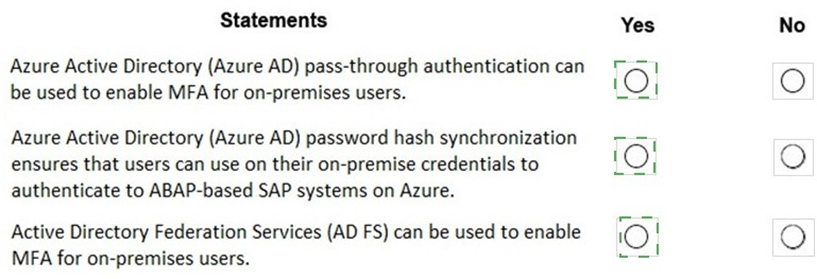Topic 2: Misc. Questions
You have an on-premises SAP NetWeaver deployment that uses Windows Server 2016 and Microsoft SQL Server 2016. You need to migrate the deployment to an Azure virtual machine that runs Windows Server 2016 and has Microsoft SQL Server 2019 installed. Which migration method should you use?
A.
heterogeneous SAP classical migration
B.
classical SAP Database Migration Option (DMO)
C.
lift-and-shift
D.
Azure Migrate
classical SAP Database Migration Option (DMO)
Your on-premises network contains SAP and non-SAP applications. You have JAVA-based SAP systems that use SPNEGO for single-sign on (SSO) authentication. Your external portal uses multi-factor authentication (MFA) to authenticate users. You plan to extend the on-premises authentication features to Azure and to migrate the SAP applications to Azure. For each of the following statements, select Yes if the statement is true. Otherwise, select No. NOTE: Each correct selection is worth one point.

Answer:

Explanation:
Box 1: Yes
Box 2: Yes
Password hash synchronization is one of the sign-in methods used to accomplish hybrid identity. Azure AD Connect synchronizes a hash, of the hash, of a users password from an on-premises Active Directory instance to a cloud-based Azure AD instance.
Password hash synchronization is an extension to the directory synchronization feature implemented by Azure AD Connect sync. You can use this feature to sign in to Azure AD services like Office 365. You sign in to the service by using the same password you use to sign in to your on-premises Active Directory instance.
Box 3: Yes
If your organization is federated with Azure AD, you can use Azure Multi-Factor Authentication to secure AD FS resources, both on-premises and in the cloud. Azure MFA enables you to eliminate passwords and provide a more secure way to authenticate.
You plan to deploy an SAP landscape on Azure that will use SAP HANA on Azure (Large Instances). You need to ensure that outbound traffic from the application tier can flow network virtual appliances (NVAs)only to the database tier. What should you use?
A.
network virtual appliances (NVAs)
B.
network security groups (NSGs)
C.
application security groups
D.
Azure Firewall
application security groups
For each of the following statements, select Yes if the stamen is true. Otherwise, select No. NOTE: Each correct selection is worth one point.

Answer:

Explanation:
Yes, Yes, No
You plan to deploy an SAP environment on Azure that will use Azure Availability Zones. Which load balancing solution supports the deployment?
A.
Azure Basic Load Balancer
B.
Azure Standard Load Balancer
C.
Azure Application Gateway v1 SKU
Azure Standard Load Balancer
Explanation:
When you deploy Azure VMs across Availability Zones and establish failover solutions within the same Azure region, some restrictions apply:
You can't use an Azure Basic Load Balancer to create failover cluster solutions
based on Windows Server Failover Clustering or Linux Pacemaker. Instead, you need to use the Azure Standard Load Balancer SKU.
You have an SAP production landscape that uses SAP HANA databases. You configure a metric alert for the primary HANA server as shown in the following exhibit.


Answer:

Explanation:

Graphical user interface, text, application, email Description automatically generated
Box 1: No
The period is 15 minutes. Only alerts or emails will be sent. Box 2: Yes
Box 3: Yes
You need direct connectivity from an on-premises network to SAP HANA (Large Instances). The solution must meet the following requirements: Minimize administrative effort. Provide the highest level of resiliency.
What should you use?
A.
ExpressRoute Global Reach
B.
Linux IPTables
C.
ExpressRoute
D.
NGINX as a reverse proxy
ExpressRoute
Explanation:
https://docs.microsoft.com/en-us/azure/virtual-machines/workloads/sap/hana-network- architecture
Express Route Global Reach Microsoft introduced a new functionality called ExpressRoute Global Reach. Global Reach can be used for HANA Large Instances in two scenarios: Enable direct access from on-premises to your HANA Large Instance units deployed in different regions Enable direct communication between your HANA Large Instance units deployed in different regions Direct Access from on-premises In the Azure regions where Global Reach is offered, you can request enabling the Global Reach functionality for your ExpressRoute circuit that connects your on-premises network to the Azure virtual network that connects to your HANA Large Instance units as well.
You have an SAP Cloud Platform subscription and an Azure Active Directory (Azure AD) tenant. You need to ensure that Azure AD users can access SAP Cloud App by using their Azure AD credentials. What should you configure?
A.
Active Directory Domain Services (AD DS)
B.
SAP Cloud Platform Identity Authentication
C.
A conditional access policy
D.
SAP Cloud Connector
Active Directory Domain Services (AD DS)
Explanation:
When you integrate SAP Cloud Platform Identity Authentication with Azure AD, you can: Control in Azure AD who has access to SAP Cloud Platform Identity Authentication.
Enable your users to be automatically signed-in to SAP Cloud Platform Identity Authentication with their Azure AD accounts.
Manage your accounts in one central location - the Azure portal.
You deploy an SAP environment on Azure. You need to ensure that incoming requests are distributed evenly across the application servers. What should you use?
A.
SAP Web Dispatcher
B.
SAP Solution Manager
C.
SAP Control
D.
Azure Monitor
SAP Web Dispatcher
Explanation:
The SAP Web Dispatcher (SWD) component is used as a load balancer for SAP traffic among the SAP application servers.
A customer enterprise SAP environment plans to migrate to Azure. The environment uses servers that runs Windows Server 2016 and Microsoft SQL Server. The environment is critical and requires a comprehensive business continuity and disaster recovery (BCDRJ strategy that minimizes the recovery point objective (RPO) and the recovery time objective (RTO). The customer wants a resilient environment that has a secondary site that is at least 250 Kilometers away. You need to recommend a solution for the customer.
Which two solutions should you recommend? Each correct answer presents part ot the solution. NOTE; Each correct selection Is worth one point.
A.
an internal load balancer to route Internet traffic
B.
warm standby virtual machines in Azure Availability Zones.
C.
warn standby virtual machines in paired regions
D.
Warm standby virtual machine an Azure Availability Set that uses geo-redundant storage (GRS)
E.
Azure Traffic Manager to route incoming traffic.
an internal load balancer to route Internet traffic
warn standby virtual machines in paired regions
Explanation: References:
https://docs.microsoft.com/en-us/azure/virtual-machines/workloads/sap/sap-hana- availability-one-region
You have an SAP production landscape on-premises and an SAP development landscape on Azure. You deploy a network virtual appliance to act as a firewall between the Azure subnet and the on-premises network. Solution: You configure a user-defined route table. Does this meet the goal?
A.
Yes
B.
No
No
You plan to migrate an on-premises SAP environment to Azure. You need to identity whether any SAP application servers host multiple SAP system identifiers (SlDs). What should you do?
A.
Run SAP HAN A sizing report.
B.
From the SAP EarlyWatch Alert report, compare the physical host names to the virtual host names.
C.
Run the SAP Report from ABAPMeter.
D.
From the SAP EarlyWatch Alert report, compare the services to the reference objects
Run the SAP Report from ABAPMeter.
| Page 3 out of 19 Pages |
| Previous |